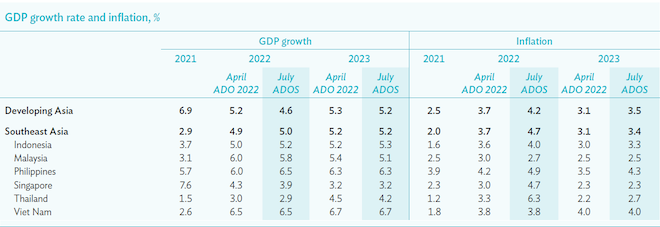
Consumption growth in Southeast Asia rebounded strongly between January and May this year. Photo credit: ADB.
Indonesia and the Philippines are expected to grow faster this year amid increased domestic demand as COVID-19 restrictions are relaxed and borders reopen.
The Asian Development Bank (ADB) has raised the 2022 economic growth forecast for Southeast Asia to 5.0% this year from 4.9% amid increased domestic demand because of more relaxed COVID-19 restrictions and the reopening of borders.
In its Asian Development Outlook (ADO) 2022 Supplement, ADB also sees faster growth for Indonesia and the Philippines in 2022 than was forecast in April.
However, the outlook for developing Asia as a whole was revised downwards to 4.6% this year from 5.2% because of slower expansion in the People’s Republic of China (PRC), more aggressive monetary tightening in advanced economies, and fallout from the war in Ukraine. ADB also raised its forecast for inflation in the region, amid higher prices for food and fuel.

Note: Developing Asia refers to the 46 members of the Asian Development Bank.
According to the ADO Supplement, consumption growth in Southeast Asia rebounded strongly between January and May this year. Higher manufacturing and services output in most economies is creating jobs and increasing incomes. Still, like the rest of developing Asia, the region is suffering from higher oil prices, rising interest rates, and trade and supply disruptions, with smaller economies more heavily affected. Even in countries with high vaccination rates, tourism is picking up at a slow pace.
ADB raised its growth forecast for Indonesia to 5.2% this year from the April forecast of 5.0% because of healthy domestic demand and steady export growth. The ADO Supplement sees higher inflation at 4.0 as a result of high commodity prices. For 2023, ADB projects the economy to grow by 5.3% and inflation to be 3.3%.
“Economic activity in Indonesia continues to normalize while COVID-19 infections remain manageable, despite a recent rise in the number of cases,” said ADB Country Director for Indonesia Jiro Tominaga. “Inflation has risen, hurting households’ purchasing power. High prices for key commodity exports, however, are generating windfall export earnings and fiscal revenue, enabling the government to provide aid for costlier food, electricity, and fuel while still reducing the budget deficit.”
The Philippine economy is forecast to grow at least 6.5% in 2022 from the April forecast of 6%, following the relaxation of COVID-19 mobility restrictions in the country, the expansion of the COVID-19 vaccination program, and a rebound in investment and household consumption. The growth projection for 2023 remains at 6.3%. Downside risks to growth in the second half of 2022 may come from sharper-than-expected slowdowns in major industrial economies, possible sustained elevated global commodity prices, and tighter financial conditions.
“The Philippine economy’s growth momentum has accelerated close to its ideal growth path,” said ADB Philippines Country Director Kelly Bird. “Strong domestic demand supported by a pick-up in employment and remittance inflows, private investment expansion, and large public infrastructure projects will underpin the country’s recovery from the economic impact of the pandemic.”
Wider COVID-19 vaccination coverage, with adolescents among those getting inoculated, and relatively mild health impacts from the Omicron variant have allowed the government to relax restrictions starting in the first quarter of the year. This in turn spurred a resumption in expanded operations for most private businesses, with the unemployment rate falling to near pre-pandemic levels. The unemployment rate was at 6.0% in May 2022, down from 7.7% a year earlier.
Inflation is forecast to quicken to 4.9% and 4.3% in 2022 and 2023 because of higher global commodity prices.
The government is expected to sustain public spending on priority infrastructure projects under the “Build Build Build” program. Among these priority projects receiving ADB financing are the Malolos Clark Railway Project, South Commuter Railway Project, EDSA Greenways Project, and the Metro Manila Bridges Project.
In the meantime, the growth forecast for Malaysia was lowered to 5.8% for 2022 and 5.1% for 2023 as increased uncertainty and weaker global growth dampened the country’s prospects. The ADO Supplement said the economy grew by 5% in the first quarter on the back of strong private consumption and increased government assistance. However, it noted a slow business recovery, including in tourism, and marginal growth in the agriculture sector.
This article was first published by BIMP-EAGA on 22 July 2022.


